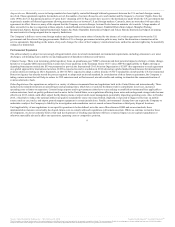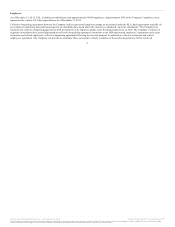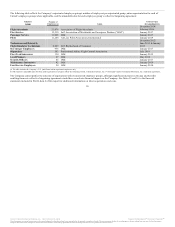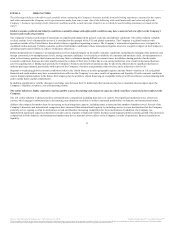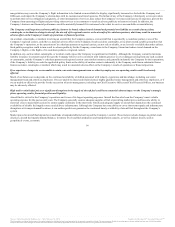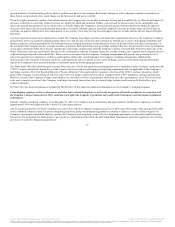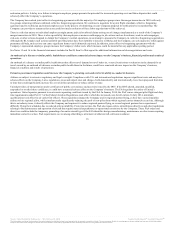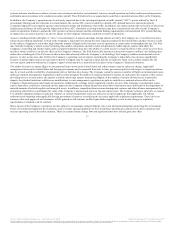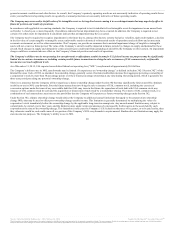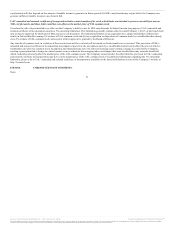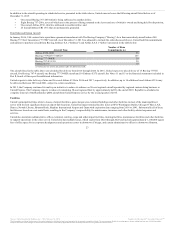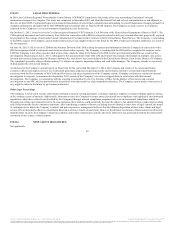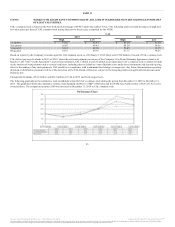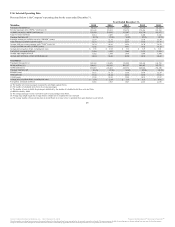United Airlines 2015 Annual Report Download - page 19
Download and view the complete annual report
Please find page 19 of the 2015 United Airlines annual report below. You can navigate through the pages in the report by either clicking on the pages listed below, or by using the keyword search tool below to find specific information within the annual report.
and that apply to the Company, including the European Union’s Emissions Trading Scheme, the State of California’s GHG cap and trade regulations,
environmental taxes for certain international flights, limited GHG reporting requirements and land-use planning laws which could apply to airports and could
affect airlines in certain circumstances. In addition, there is the potential for additional regulatory actions in regard to the emission of GHGs by the aviation
industry. The precise nature of future requirements and their applicability to the Company are difficult to predict, but the financial impact to the Company
and the aviation industry would likely be adverse and could be significant.
In 2016, the U.S. Congress will continue to consider legislation to reauthorize the FAA, which encompasses all significant aviation tax and policy related
issues. As with previous reauthorization legislation, the U.S. Congress may consider a range of policy changes that could impact the Company’s operations
and costs.
See Part I, Item 1, Business—Industry Regulation, of this report for additional information on government regulation impacting the Company.
The airline industry may undergo further change with respect to alliances and joint ventures, either of which could have a material adverse effect on the
Company.
The Company faces and may continue to face strong competition from other carriers due to the modification of alliances and formation of new joint ventures.
Carriers may improve their competitive positions through airline alliances, slot swaps and/or joint ventures. Certain types of airline joint ventures further
competition by allowing multiple airlines to coordinate routes, pool revenues and costs, and enjoy other mutual benefits, achieving many of the benefits of
consolidation. “Open Skies” agreements, including the agreements between the United States and the European Union and between the United States and
Japan, may also give rise to better integration opportunities among international carriers. Movement of airlines between current global airline alliances could
reduce joint network coverage for members of such alliances while also creating opportunities for joint ventures and bilateral alliances that did not exist
before such realignment. There is ongoing speculation that further airline and airline alliance consolidations or reorganizations could occur in the future,
especially if new “Open Skies” agreements between Brazil and the United States and Mexico and the United States are fully implemented. The Company
routinely engages in analysis and discussions regarding its own strategic position, including current and potential alliances, asset acquisitions and
divestitures and may have future discussions with other airlines regarding strategic activities. If other airlines participate in such activities, those airlines may
significantly improve their cost structures or revenue generation capabilities, thereby potentially making them stronger competitors of the Company and
potentially impairing the Company’s ability to realize expected benefits from its own strategic relationships.
Inadequate liquidity or a negative impact on the Company’s liquidity from factors beyond the Company’s control may have a material adverse effect on
the Company’s financial position and business.
The Company has a significant amount of financial leverage from fixed obligations, including aircraft lease and debt financings, leases of airport property
and other facilities, and other material cash obligations. In addition, the Company has substantial noncancelable commitments for capital expenditures,
including for the acquisition of new aircraft and related spare engines.
Although the Company’s cash flows from operations and its available capital, including the proceeds from financing transactions, have been sufficient to
meet these obligations and commitments to date, the Company’s future liquidity could be negatively affected by the risk factors discussed in this Item 1A.,
including, but not limited to, substantial volatility in the price of fuel, adverse economic conditions, disruptions in the global capital markets and
catastrophic external events.
If the Company’s liquidity is constrained due to the various risk factors noted in this Item 1A. or otherwise, the Company might not be able to timely pay its
debts or comply with certain operating and financial covenants under its financing and credit card processing agreements or with other material provisions of
its contractual obligations. These covenants require the Company or United, as applicable, to maintain minimum liquidity and/
18
Source: United Continental Holdings, Inc., 10-K, February 18, 2016 Powered by Morningstar® Document Research℠
The information contained herein may not be copied, adapted or distributed and is not warranted to be accurate, complete or timely. The user assumes all risks for any damages or losses arising from any use of this information,
except to the extent such damages or losses cannot be limited or excluded by applicable law. Past financial performance is no guarantee of future results.


